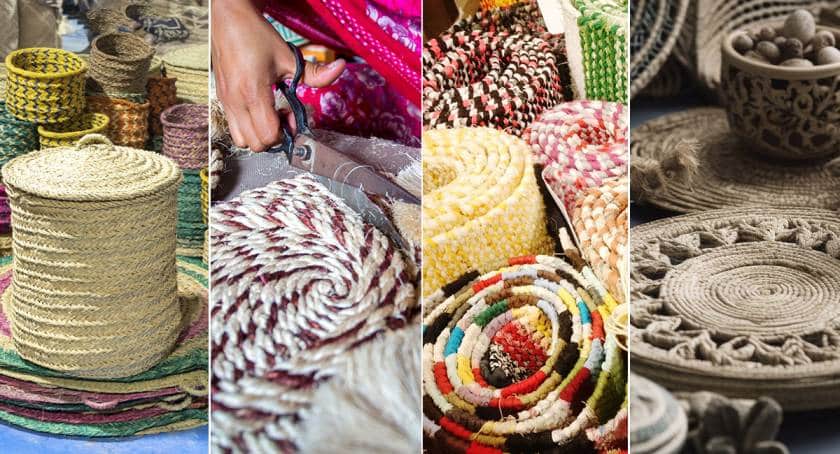Handicrafts Jute Craft of Odisha
Odisha, a land of rich cultural heritage and artistic traditions, is renowned for its diverse handicrafts. Among these, jute craft is an eco-friendly and sustainable art form that artisans have practiced for generations. Odisha’s artisans have mastered transforming raw jute fibers into beautiful decorative and utility items, blending traditional artistry with modern designs. Jute Craft showcases Odisha’s artistic excellence and contributes significantly to sustainable living by promoting biodegradable products.
Rich History of Jute Craft
The history of jute craft in Odisha traces back to ancient times when people extensively used natural fibers for household and decorative items. Jute, known for its durability and versatility, became integral to daily life. Artisans discovered innovative ways to weave and shape jute into baskets, mats, ropes, and other essentials. Over time, this craft evolved, incorporating complex designs and patterns influenced by Odisha’s cultural and artistic heritage.
Earlier, people primarily used jute for utilitarian purposes, such as making ropes and sacks, which were essential for agricultural and domestic use. However, as the craft evolved, artisans began incorporating decorative elements inspired by Odisha’s traditional art forms, like Pattachitra paintings and appliqué work. Today, jute craft has transformed into a flourishing industry, with artisans producing a variety of decorative, utility, and fashion products that appeal to local and global markets.
The Process of Jute Craft Making
Creating a jute craft involves several complex steps, requiring skill and patience. The process begins with harvesting jute plants and soaking and stripping the fibers to obtain the raw material. The fibers are then cleaned, spun into threads, and dyed using natural or synthetic colors. Once artisans prepare the raw material, they employ weaving, knotting, and braiding techniques to shape the jute into beautiful products.
Some artisans use embroidery and embellishments, adding a unique aesthetic appeal to the final creation. They often create decorative pieces like wall hangings and figurines with complex designs while strengthening functional products like baskets and bags for durability. The entire process is labor-intensive and requires careful attention to detail and precision.
Key Steps in Production:
- Harvesting and Processing: Jute plants are grown and harvested, with the fibers extracted through a process known as retting.
- Cleaning and Drying: The fibers are cleaned thoroughly and dried under the sun to remove impurities.
- Spinning and Dyeing: The fibers are spun into threads and dyed vibrantly, often using natural dyes.
- Weaving and Shaping: Using traditional techniques, artisans weave or braid the jute to form various products.
- Embellishments and Finishing: Artisans adorn some items with embroidery, beads, or appliqué work before finalizing them.
Popular Items in Odisha
Odisha includes a wide range of products, each reflecting the creativity and expertise of artisans. Some of the most popular jute craft items include:
- Decorative Items: Artisans use jute to craft beautiful wall hangings, lampshades, and figurines. These items enhance home decor with their rustic and elegant appearance, showcasing Odisha’s artistic legacy. Jute wall hangings often feature complex patterns inspired by traditional motifs, while lampshades offer a unique blend of aesthetics and functionality.
- Utility Products: Artisans widely produce jute bags, baskets, mats, and coasters, offering a sustainable alternative to plastic products. These utility items are durable and biodegradable, making them an environmentally responsible choice. Jute bags, in particular, have gained immense popularity as stylish yet eco-friendly alternatives to plastic bags.
- Jewelry and Accessories: Jute jewelry, including earrings, necklaces, and bangles, has gained popularity among fashion enthusiasts. The natural texture of jute and artistic designs make these accessories unique and trendy. Fashion designers have also begun incorporating jute elements into modern accessories, giving a modern twist to this traditional craft.
- Handwoven Jute Fabrics: Odisha also produces handwoven jute fabrics, which artisans use to make garments, curtains, and upholstery. Often blended with cotton or silk, these fabrics provide stylish yet eco-friendly clothing and home decor options. Fusing jute with other materials enhances its durability and aesthetic appeal, making it a preferred choice for sustainable fashion.
Jute Craft and Sustainable Living
As the world moves towards sustainability, jute craft has emerged as a perfect example of an eco-friendly industry. Jute is an excellent substitute for synthetic products because it is a renewable and biodegradable resource. By promoting jute craft, Odisha contributes to environmental conservation while preserving its cultural heritage. Consumers increasingly opt for jute products, reducing plastic waste and supporting local artisans.
The government and various NGOs have also taken initiatives to promote jute craft by providing training, financial support, and marketing platforms for artisans. These efforts have helped create livelihood opportunities for rural communities while preserving an age-old craft tradition.
Creative Innovations Revolutionizing the Jute Craft Industry
To keep up with modern trends, artisans in Odisha continuously innovate their jute craft techniques. Experimenting with new patterns, color combinations, and fusions with other materials has given rise to modern jute products that appeal to global markets. Designers collaborate with traditional artisans to create fashionable jute handbags, footwear, and home accessories that seamlessly blend tradition with modernity. These innovations enhance the aesthetic value of jute craft and expand its reach to a broader audience.
Introducing eco-friendly dyes, advanced weaving techniques, and modern designs has further enhanced the appeal of jute products. Online platforms and e-commerce sites have also provided artisans a global marketplace, enabling them to showcase their creations to international buyers.
A Lasting Legacy
Odisha’s jute craft is more than just an art form; it is a legacy of sustainable living and skilled artistry. People can support local artisans and contribute to environmental conservation by accepting jute products. With continuous efforts to promote and innovate this craft, Odisha’s jute industry has the potential to thrive and gain global recognition. As the demand for sustainable products increases, jute craft will continue to play a vital role in promoting eco-friendly practices while preserving Odisha’s rich cultural heritage.


